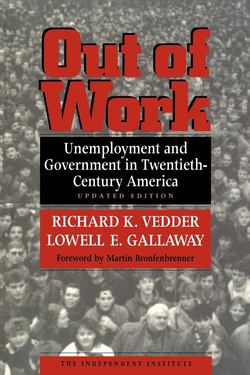Читать книгу Out of Work - Richard K Vedder - Страница 38
На сайте Литреса книга снята с продажи.
The Unemployment Experience, 1900–1929
ОглавлениеMoving to a less aggregated view of the period, table 4.1 shows the unemployment experience, by individual year, for the first three decades of the century. Only in 1921 did the unemployment rate average more than 8.5 percent for a single year. The notion that very high unemployment levels were commonplace in the era before major macroeconomic policy intervention by government does not seem to be supported by the empirical evidence. In 80 percent of the years, the unemployment rate averaged less than 6 percent for the year, a rate that today is considered fairly low.
When relatively high unemployment developed during recessionary periods, it did not tend to persist.6 There were three episodes (about one a decade) in which unemployment rose above 8 percent. In none of those instances did unemployment remain at an 8 percent or higher average for two consecutive years. After peaking at 8 percent in 1908, unemployment dropped sharply to slightly over 5 percent the following year. After peaking in 1915 at 8.5 percent, the unemployment rate plunged 40 percent in 1916 to a near normal 5.1 percent rate. Even in 1921, when the unemployment rate soared to 11.7 percent, recovery came quickly, with the unemployment rate falling 43 percent in the following year to under 7 percent.
TABLE 4.1 UNEMPLOYMENT IN THE UNITED STATES, 1900–1929
A similar flexibility in the unemployment rate occurred when low unemployment existed. Only once, in 1918 and 1919, was one year of very low unemployment (2.5 percent or less) followed by a second year of similar very low joblessness. Generally unemployment tended to gravitate fairly quickly back to something approximating its natural rate. Only once, from 1906 to 1908, was the unemployment rate outside the 3 to 6 percent range (annual average) for three consecutive years, and even in 1906–8, the rate went through the natural rate range, going from below 3 percent in 1906 and 1907 to above 6 percent in 1908.
There is some dispute about the unemployment statistics as they relate to this period. As previously indicated, Christina Romer believes that in general unemployment rates fluctuated less than the Lebergott/BLS statistics show.7 Regarding the 1920s, R. M. Coen has argued that the rates for most of that decade tend to be understated.8 After 1922, for which he records a 7.3 percent unemployment rate, Coen finds annual unemployment rates for the rest of the decade ranged between 4 and 6 percent in every single year. Although his average rate is higher than the BLS estimates, even Coen finds rates that tended to cluster between 3 and 6 percent.
In chapter 3, we argued that variations in unemployment in the twentieth century are largely explainable in terms of changes in “the adjusted real wage,” or the compensation of workers in terms of purchasing power related to their productivity or output. Unemployment will tend to rise with increases in the adjusted real wage, which in turn can reflect rising money-wage rates, falling prices, or falling productivity of labor. Similarly, a fall in the adjusted real wage tends to reduce unemployment, ceteris paribus. Falling adjusted real wages can result from one or a combination of three factors: falling money wages, rising prices, or rising labor productivity. Several variants of the basic model were developed, and the one used here is taken from table 3.3, which suggests unemployment in this year depends on changes in the components of the real wage over the past six years, plus the adjusted real wage itself lagged seven years.
Table 4.2 indicates the actual unemployment rate by year for the 1900–1929 period, as well as the unemployment rate predicted by our adjusted real wage model. The model does reasonably well in forecasting major shifts in the unemployment rate. In no year did the actual unemployment rate deviate from the rate predicted by our model by more than three percentage points (e. g., 7.0 percent vs. 4.0 percent.) In 70 percent of the years, the deviation of the predicted unemployment rate from the actual rate was less than one percentage point. The model does a remarkably good job of predicting major increases in unemployment. The first major episode of moderately high unemployment comes after the panic of 1907. Unemployment rose from 2.8 to 8.0 percent, while the adjusted real wage model predicts a rise from about 0.5 to over 7.7 percent. Similarly, in 1914 and 1915, unemployment again rose to the 8 percent range for two years, up from the 4.3 percent level prevailing in 1913. Our model predicts a rise to a peak rate slightly over 8.8 percent in 1915, very near the actual rate.
TABLE 4.2 ACTUAL VS. PREDICTED UNEMPLOYMENT RATES FOR THE U.S. 1900–1929
The major downturn of the first three decades was the 1920–21 depression. Unemployment was abnormally low in 1919, 1.4 percent, rising to 5.2 percent in 1920 and 11.7 percent in 1921 before falling to 6.7 percent in 1922 and 2.4 percent in 1923. The wage model actually predicted negative unemployment in 1919. In the most important forecasting error for this era, the model predicts a rise in unemployment in 1920, but to only slightly over 2.3 percent. Yet the model accurately explains the huge rise in unemployment in 1921 (predicting a 12.1 percent rate), and a significant decline in unemployment in 1922 and 1923 (the model shows unemployment rates of 8.6 and 2.1 percent, respectively, for these years).
In the halcyon days from 1923 through 1929, unemployment varied modestly, ranging between 1.8 and 5.0 percent; our statistical explanation indicates values between 2.1 and 4.3 percent, not a very large discrepancy. In short, variations in unemployment during the Gilded Age are well explained by movements in money wages, prices, and labor productivity.
